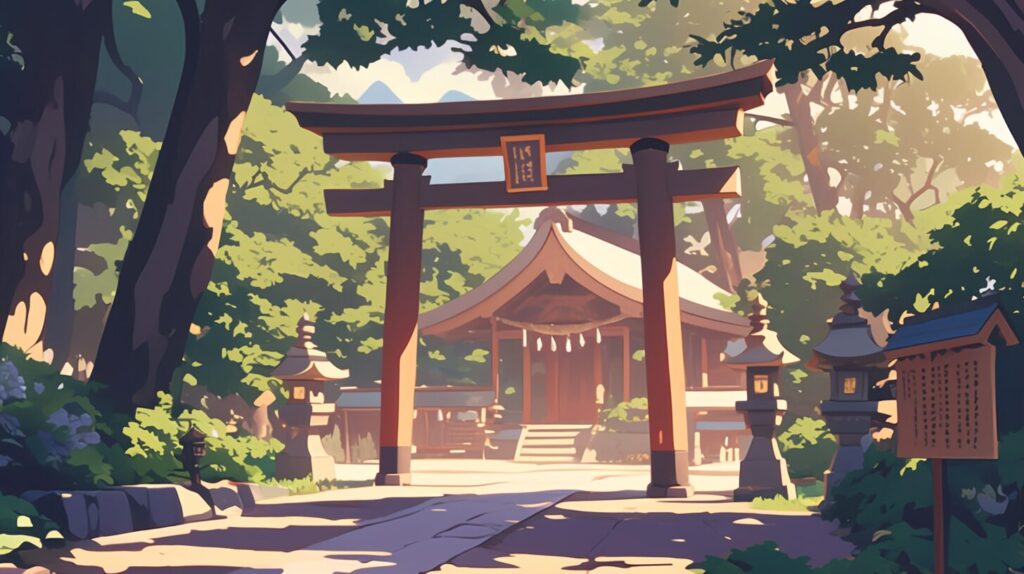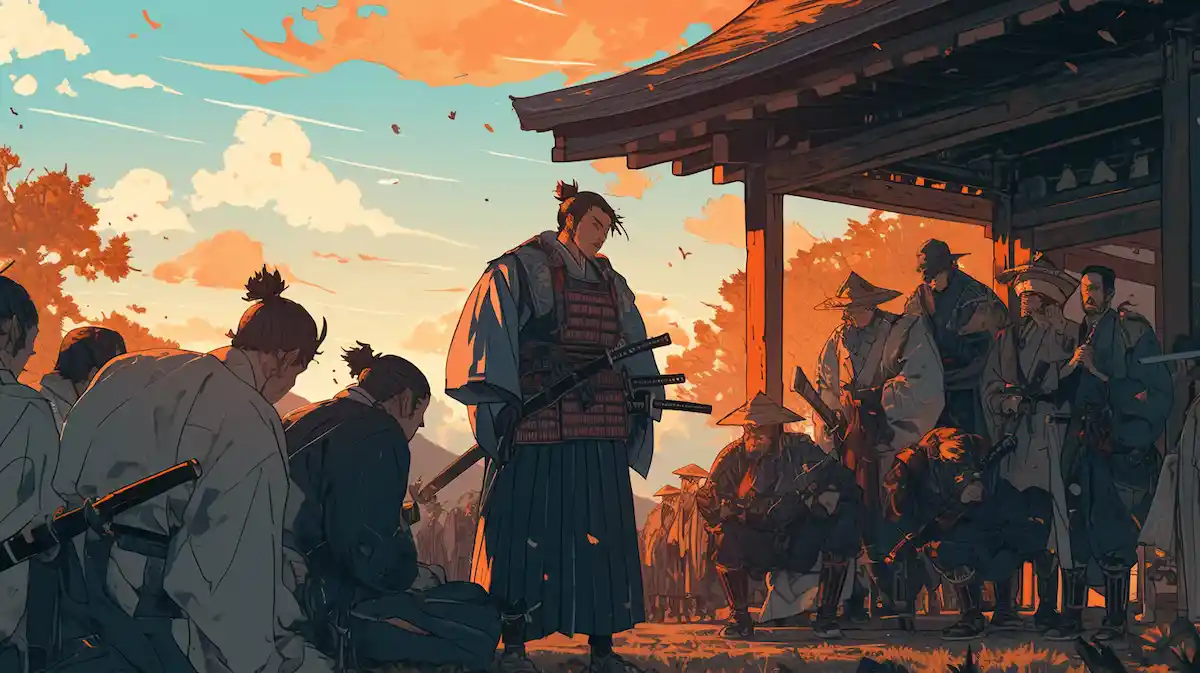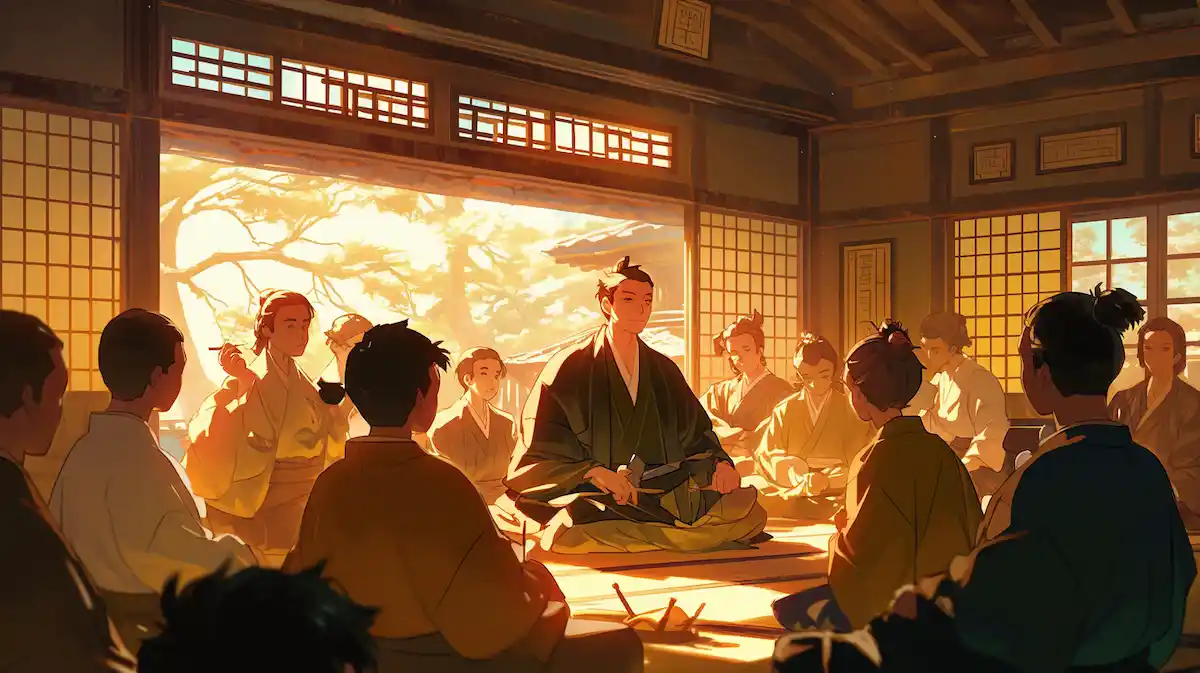吉田松陰を英語で説明・紹介するための基本情報と、英会話に役立つ表現をシンプルでわかりやすい英語で紹介します。
英会話ダイアローグ・概要・10の質問を通して、吉田松陰に関する英語表現を学びます。
英語
英会話ダイアローグを読む前に知っておくと良い前提知識と情報です。
- 吉田松陰の基本情報
- 幕末の思想家・教育者であり長州藩の侍
- 松下村塾で多くの明治維新のリーダーを育てた
- 黒船に密航を試み、西洋の知識を学ぼうとした
- 弟子たちが後の日本の近代化を推進し、松陰の思想が大きな影響を与えた
- 松下村塾について
- 松陰が運営した私塾で、身分や地位に関係なく「志」を持つ者を受け入れた
- 討論や実践を重視し、単なる知識の暗記ではなく、行動力と考える力を育てた
- 吉田松陰の教え子たちが、その後の明治維新で重要な役割を果たした
- 高杉晋作:倒幕運動のリーダー
- 伊藤博文:日本初代内閣総理大臣
- 山県有朋:日本の軍事制度の基礎を築いた
- 松陰の行動と思考
- 黒船密航事件:1854年、ペリーの黒船に密航し、アメリカへ渡ろうとしたが失敗
- 獄中での教育活動:野山獄(長州藩の牢獄)で囚人たちに教育を行い、自らも学び続けた
- 彼の信念:「行動を伴わない学問は意味がない」と考え、実践を重視
- 死後の評価
- 最期:安政の大獄で処刑(29歳)、処刑後も彼の教えは弟子たちによって引き継がれ、日本の近代化の基礎となる
- 遺言の象徴:「身はたとひ朽ちぬとも、留め置かまし大和魂」、彼の精神が後世に影響を与えることを信じた
- 関連する場所
- 松陰神社(山口県萩市):松下村塾や彼の墓がある場所
- 松陰神社(東京都世田谷区):弟子たちが遺骨を埋葬した場所
- 野山獄跡(山口県萩市):獄中で彼が多くの思想を深めた場所
- 吉田松陰の名言
- 「夢なき者に成功なし」:夢や志を持つことの大切さを説いた言葉
- 「草莽崛起(そうもうくっき)」:一般の人々が立ち上がり、社会を変える力を持っていることを示した
2人が吉田松陰について話しています。
松陰の生涯、松下村塾での教育活動、ペリー来航時の密航未遂事件、松陰の思想や影響力が明治維新に繋がったことなどを話題にしています。
会話 / dialogue

Hey, Key. Do you know much about Yoshida Shoin? I’ve been hearing his name a lot recently and wanted to learn more.

Oh, Yoshida Shoin? He’s one of Japan’s most famous historical figures, especially from the late Edo period. What sparked your interest?

I visited Shoin Shrine in Setagaya the other day. The atmosphere was incredible, but I didn’t know much about him. Why is he so important?

That’s a great starting point! Shoin was a samurai and an educator from the Choshu Domain. He’s most famous for running a school called Shokasonjuku, where he taught many of the leaders of the Meiji Restoration.

What made his school so special?

Well, unlike most schools at that time, Shoin didn’t care about social status. He welcomed anyone with the passion to learn and contribute to Japan’s future. His teaching style focused on discussion and practical action rather than just memorizing texts.

That’s pretty progressive for the Edo period. What kind of things did he teach?

It wasn’t just about knowledge—he taught leadership and the importance of having a strong will or kokorozashi. His students learned how to think critically about Japan’s future. And it worked—his students included figures like Takasugi Shinsaku and Ito Hirobumi, who played key roles in modernizing Japan.

Interesting. I also heard something about him trying to board the Black Ships. What’s the story there?

Oh, that’s one of his most famous episodes! In 1854, when Commodore Perry came to Japan with the Black Ships, Shoin wanted to learn about Western technology and culture. He even tried to secretly board one of Perry’s ships to travel to America.

Really? That’s bold. Did it work?

Unfortunately, no. The Americans refused, and Shoin later turned himself in to the authorities. He was imprisoned in Noyama Prison, but even there, he kept teaching the other prisoners and writing about his ideas.

So he didn’t let anything stop him, even prison?

Exactly. That’s what makes him so inspiring. He believed that education and action could change the country. One of his famous quotes is, “Even if my body decays, my spirit will remain.” It shows his commitment to leaving a lasting legacy.

What happened to him after prison?

He was executed in 1859 during the Ansei Purge, a political crackdown by the Tokugawa shogunate. But his teachings and ideas lived on through his students, who helped drive the Meiji Restoration.

That’s such a short life, but it sounds like he had a huge impact.

Definitely. His legacy isn’t just about his own actions—it’s about how he inspired others to act. His school, Shokasonjuku, became the foundation for a lot of the changes that shaped modern Japan.

I can see why he’s so respected. What about his shrine in Setagaya? Why is it there?

That’s where his students buried his remains after his execution. They wanted to honor him and keep his spirit alive. It’s a peaceful place, isn’t it?

It really is. Visiting it made me want to learn more about him. Do you think I should check out other places related to him?

Absolutely! If you’re really interested, you should visit Shokasonjuku and his birthplace in Hagi, Yamaguchi Prefecture. That’s where you can really feel his legacy.

Sounds like a great idea. Thanks for all the info, Key. I feel like I know so much more about Yoshida Shoin now.

Anytime! He’s a fascinating figure, and there’s always more to learn about him.

I’m definitely inspired. Maybe I’ll start reading one of his books or visit Hagi soon!
概要 / Overview
「吉田松陰」について、理解を深めるための「英語での概要」です。
吉田松陰

Who Was Yoshida Shoin?
Yoshida Shoin (1830–1859) was a Japanese samurai, educator, and thinker during the late Edo period. He was born in Hagi, Choshu Domain (now Yamaguchi Prefecture), and became one of the most influential figures of his time. Shoin is famous for his efforts to modernize Japan and educate future leaders, even though he lived only 29 years. His ideas and actions inspired many people and played a key role in Japan’s Meiji Restoration.
Shokasonjuku: A Revolutionary School
Shoin ran a private school called Shokasonjuku in Hagi. Unlike other schools of that time, Shokasonjuku welcomed students from any social class as long as they had the passion to learn. Shoin’s teaching style focused on discussion and practical learning instead of rote memorization. He encouraged students to think critically about Japan’s future and develop strong leadership skills. His students included famous leaders like Takasugi Shinsaku and Ito Hirobumi, who later became Japan’s first Prime Minister.
The Black Ship Incident
One of Shoin’s most famous stories is his attempt to board the Black Ships in 1854. When Commodore Perry brought his fleet to Japan, Shoin wanted to learn about Western technology and culture. He even tried to secretly board one of the ships to travel to America. However, the Americans refused, and Shoin later turned himself in to the authorities. He was imprisoned but continued teaching and writing during his time in jail.
Beliefs and Famous Quotes
Shoin believed that education and action could change Japan. He often emphasized the importance of having a strong will, or “志” (kokorozashi). One of his famous quotes is, “Even if my body decays, my spirit will remain.” This shows his belief in leaving a lasting legacy through his ideas and students.
Legacy and Influence
In 1859, Shoin was executed during the Ansei Purge, a political crackdown by the Tokugawa shogunate. Despite his short life, his teachings lived on through his students, who helped lead the Meiji Restoration. Today, places like Shokasonjuku and Shoin Shrine in Yamaguchi and Tokyo honor his memory. Shoin remains a symbol of courage, education, and the power of leadership.
10の質問 / 10 questions
「吉田松陰」について、理解を深めるための「英語での10の質問」です。
1. Who was Yoshida Shoin?
Yoshida Shoin was a Japanese samurai, educator, and thinker during the late Edo period. He is known for his efforts to modernize Japan and for teaching future leaders.
2. What was Shokasonjuku?
Shokasonjuku was a private school run by Yoshida Shoin in Hagi. It welcomed students from any social class who had a passion to learn and focused on discussion and practical learning.
3. Why is Yoshida Shoin significant in Japanese history?
He educated many leaders who played key roles in the Meiji Restoration, which transformed Japan into a modern state.
4. What was the Black Ship Incident involving Yoshida Shoin?
In 1854, Shoin attempted to board Commodore Perry’s Black Ships to learn about Western technology and culture but was unsuccessful and later imprisoned.
5. How did Yoshida Shoin continue his educational activities while in prison?
Even in prison, Shoin taught fellow inmates and wrote about his ideas, demonstrating his commitment to education.
6. What is one of Yoshida Shoin’s famous quotes?
One of his famous quotes is, “Even if my body decays, my spirit will remain,” reflecting his belief in leaving a lasting legacy.
7. How did Yoshida Shoin’s teachings influence Japan’s modernization?
His teachings inspired his students, who became key figures in overthrowing the Tokugawa shogunate and establishing a modern government during the Meiji Restoration.
8. What happened to Yoshida Shoin during the Ansei Purge?
He was executed in 1859 during the Ansei Purge, a political crackdown by the Tokugawa shogunate against dissenters.
9. Where can one visit sites related to Yoshida Shoin today?
Visitors can explore Shokasonjuku and Shoin Shrine in Hagi, Yamaguchi Prefecture, and another Shoin Shrine in Setagaya, Tokyo.
10. What was Yoshida Shoin’s approach to social status in education?
He disregarded social status, welcoming any student eager to learn, which was progressive for his time.

和訳付
会話 / dialogue

Hey, Key. Do you know much about Yoshida Shoin? I’ve been hearing his name a lot recently and wanted to learn more.
ねえ、キー。吉田松陰について詳しい?最近彼の名前をよく聞くんだけど、もっと知りたくなってさ。

Oh, Yoshida Shoin? He’s one of Japan’s most famous historical figures, especially from the late Edo period. What sparked your interest?
吉田松陰?彼は日本で特に幕末に有名な歴史上の人物だよ。どうして興味を持ったの?

I visited Shoin Shrine in Setagaya the other day. The atmosphere was incredible, but I didn’t know much about him. Why is he so important?
この前、世田谷の松陰神社に行ったんだ。雰囲気がすごく良かったけど、彼についてあまり知らなくて。なぜそんなに重要なの?

That’s a great starting point! Shoin was a samurai and an educator from the Choshu Domain. He’s most famous for running a school called Shokasonjuku, where he taught many of the leaders of the Meiji Restoration.
それはいいきっかけだね!松陰は長州藩の侍で教育者だったんだ。彼は松下村塾という学校を運営していて、明治維新のリーダーを多く育てたことで有名だよ。

What made his school so special?
彼の学校が特別だった理由は何?

Well, unlike most schools at that time, Shoin didn’t care about social status. He welcomed anyone with the passion to learn and contribute to Japan’s future. His teaching style focused on discussion and practical action rather than just memorizing texts.
当時のほとんどの学校と違って、松陰は身分を気にしなかったんだ。学びたいという情熱と日本の未来に貢献したいという意志があれば、誰でも歓迎したよ。彼の教育は、ただ暗記するのではなく、議論や実践を重視していたんだ。

That’s pretty progressive for the Edo period. What kind of things did he teach?
江戸時代にしてはかなり進んでるね。どんなことを教えてたの?

It wasn’t just about knowledge—he taught leadership and the importance of having a strong will or kokorozashi. His students learned how to think critically about Japan’s future. And it worked—his students included figures like Takasugi Shinsaku and Ito Hirobumi, who played key roles in modernizing Japan.
知識だけじゃなくて、リーダーシップや「志」の大切さも教えてたよ。彼の生徒たちは日本の未来を批判的に考える力を身につけたんだ。そして実際に、高杉晋作や伊藤博文のような日本の近代化に大きく貢献した人物を育てたんだよ。

Interesting. I also heard something about him trying to board the Black Ships. What’s the story there?
面白いね。それと、彼が黒船に乗ろうとしたって聞いたけど、それはどんな話?

Oh, that’s one of his most famous episodes! In 1854, when Commodore Perry came to Japan with the Black Ships, Shoin wanted to learn about Western technology and culture. He even tried to secretly board one of Perry’s ships to travel to America.
ああ、それは彼の有名なエピソードのひとつだね!1854年、ペリー提督が黒船で日本に来たとき、松陰は西洋の技術や文化を学びたくて、ペリーの船に密航しようとしたんだ。

Really? That’s bold. Did it work?
本当に?すごい大胆だね。それでうまくいったの?

Unfortunately, no. The Americans refused, and Shoin later turned himself in to the authorities. He was imprisoned in Noyama Prison, but even there, he kept teaching the other prisoners and writing about his ideas.
残念ながらダメだったよ。アメリカ側に断られて、その後、松陰は自首したんだ。それで野山獄に入れられたけど、そこで囚人たちに教育を続けたり、自分の考えを書き留めたりしてたんだよ。

So he didn’t let anything stop him, even prison?
つまり、牢獄に入っても彼は諦めなかったってこと?

Exactly. That’s what makes him so inspiring. He believed that education and action could change the country. One of his famous quotes is, “Even if my body decays, my spirit will remain.” It shows his commitment to leaving a lasting legacy.
その通り。それが彼が多くの人を感動させる理由だよ。彼は教育と行動が国を変えられると信じてた。「身はたとひ朽ちぬとも、留め置かまし大和魂」という有名な言葉があるけど、それは彼が後世に何かを残すことに本気だった証だね。

What happened to him after prison?
牢獄の後、彼はどうなったの?

He was executed in 1859 during the Ansei Purge, a political crackdown by the Tokugawa shogunate. But his teachings and ideas lived on through his students, who helped drive the Meiji Restoration.
1859年、安政の大獄という幕府による政治弾圧で処刑されたよ。でも、彼の教えや思想は弟子たちに受け継がれて、明治維新を推進する力になったんだ。

That’s such a short life, but it sounds like he had a huge impact.
短い人生だけど、ものすごい影響を与えたんだね。

Definitely. His legacy isn’t just about his own actions—it’s about how he inspired others to act. His school, Shokasonjuku, became the foundation for a lot of the changes that shaped modern Japan.
その通り。彼の遺産は、彼自身の行動だけじゃなくて、人々を行動に駆り立てたことにあるんだ。彼の松下村塾は、現代日本を形作る多くの変化の基盤になったんだよ。

I can see why he’s so respected. What about his shrine in Setagaya? Why is it there?
だから彼がそんなに尊敬されてるんだね。世田谷の松陰神社はどうしてそこにあるの?

That’s where his students buried his remains after his execution. They wanted to honor him and keep his spirit alive. It’s a peaceful place, isn’t it?
処刑された後、弟子たちが彼の遺骨をそこに埋葬したんだ。彼を敬い、その精神を残したかったんだよ。落ち着いた場所だよね?

It really is. Visiting it made me want to learn more about him. Do you think I should check out other places related to him?
本当にそうだね。行ったことで、もっと彼について知りたくなったよ。他のゆかりの場所にも行ってみるべきかな?

Absolutely! If you’re really interested, you should visit Shokasonjuku and his birthplace in Hagi, Yamaguchi Prefecture. That’s where you can really feel his legacy.
絶対に行くべきだよ!本当に興味があるなら、山口県萩市の松下村塾や彼の生誕地に行くといいよ。そこで彼の遺産を本当に感じられるはず。

Sounds like a great idea. Thanks for all the info, Key. I feel like I know so much more about Yoshida Shoin now.
いい考えだね。いろいろ教えてくれてありがとう、キー。吉田松陰についてすごく詳しくなった気がするよ。

Anytime! He’s a fascinating figure, and there’s always more to learn about him.
いつでもどうぞ!彼は本当に魅力的な人物だから、まだまだ学べることがあるよ。

I’m definitely inspired. Maybe I’ll start reading one of his books or visit Hagi soon!
本当に感動したよ。彼の本を読んでみたり、近いうちに萩に行ってみたりしようかな!
概要 / Overview
吉田松陰

Who Was Yoshida Shoin?
Yoshida Shoin (1830–1859) was a Japanese samurai, educator, and thinker during the late Edo period. He was born in Hagi, Choshu Domain (now Yamaguchi Prefecture), and became one of the most influential figures of his time. Shoin is famous for his efforts to modernize Japan and educate future leaders, even though he lived only 29 years. His ideas and actions inspired many people and played a key role in Japan’s Meiji Restoration.
吉田松陰とは誰か?
吉田松陰(1830年~1859年)は、幕末期の侍であり、教育者であり、思想家でした。彼は長州藩(現在の山口県)の萩で生まれ、当時の最も影響力のある人物の一人となりました。松陰は日本の近代化を進め、未来のリーダーを育てる努力をしたことで知られていますが、わずか29歳でその生涯を閉じました。彼の思想と行動は多くの人々を感動させ、明治維新において重要な役割を果たしました。
Shokasonjuku: A Revolutionary School
Shoin ran a private school called Shokasonjuku in Hagi. Unlike other schools of that time, Shokasonjuku welcomed students from any social class as long as they had the passion to learn. Shoin’s teaching style focused on discussion and practical learning instead of rote memorization. He encouraged students to think critically about Japan’s future and develop strong leadership skills. His students included famous leaders like Takasugi Shinsaku and Ito Hirobumi, who later became Japan’s first Prime Minister.
松下村塾: 革新的な学校
松陰は萩で「松下村塾」という私塾を運営していました。当時の他の学校と異なり、松下村塾は、学びたいという情熱を持つ者なら、どのような身分の人でも受け入れました。松陰の教育スタイルは暗記に頼らず、討論や実践的な学びに重点を置いていました。彼は生徒たちに日本の未来について批判的に考える力を養わせ、強いリーダーシップを育成しました。彼の生徒には、高杉晋作や後に日本初の内閣総理大臣となる伊藤博文などの有名なリーダーが含まれていました。
The Black Ship Incident
One of Shoin’s most famous stories is his attempt to board the Black Ships in 1854. When Commodore Perry brought his fleet to Japan, Shoin wanted to learn about Western technology and culture. He even tried to secretly board one of the ships to travel to America. However, the Americans refused, and Shoin later turned himself in to the authorities. He was imprisoned but continued teaching and writing during his time in jail.
黒船事件
松陰の最も有名なエピソードのひとつが、1854年の黒船に乗ろうとした試みです。ペリー提督が艦隊を率いて日本に来たとき、松陰は西洋の技術や文化を学びたいと強く願っていました。彼は密かに船に乗り込み、アメリカへ行こうとしましたが、アメリカ側に拒否され、その後自ら幕府に出頭しました。彼は投獄されましたが、獄中でも教育や執筆を続けました。
Beliefs and Famous Quotes
Shoin believed that education and action could change Japan. He often emphasized the importance of having a strong will, or “志” (kokorozashi). One of his famous quotes is, “Even if my body decays, my spirit will remain.” This shows his belief in leaving a lasting legacy through his ideas and students.
信念と有名な言葉
松陰は、教育と行動が日本を変える力になると信じていました。彼は「志(こころざし)」の重要性をよく強調していました。彼の有名な言葉のひとつに「身はたとひ朽ちぬとも、留め置かまし大和魂」があります。これは、彼が自身の思想や弟子を通じて永続的な遺産を残すことを信じていたことを示しています。
Legacy and Influence
In 1859, Shoin was executed during the Ansei Purge, a political crackdown by the Tokugawa shogunate. Despite his short life, his teachings lived on through his students, who helped lead the Meiji Restoration. Today, places like Shokasonjuku and Shoin Shrine in Yamaguchi and Tokyo honor his memory. Shoin remains a symbol of courage, education, and the power of leadership.
遺産と影響
1859年、松陰は徳川幕府による政治弾圧「安政の大獄」で処刑されました。しかし、彼の短い生涯にもかかわらず、その教えは弟子たちに受け継がれ、明治維新を推進する力となりました。現在、山口県の松下村塾や東京と山口にある松陰神社などで彼の記憶が称えられています。松陰は、勇気、教育、そしてリーダーシップの力を象徴する存在として語り継がれています。
10の質問 / 10 questions
1: Who was Yoshida Shoin?
吉田松陰とは誰ですか?
Yoshida Shoin was a Japanese samurai, educator, and thinker during the late Edo period. He is known for his efforts to modernize Japan and for teaching future leaders.
吉田松陰は幕末の侍であり、教育者であり、思想家でした。彼は日本の近代化への努力と未来のリーダーたちを教えたことで知られています。
2: What was Shokasonjuku?
松下村塾とは何ですか?
Shokasonjuku was a private school run by Yoshida Shoin in Hagi. It welcomed students from any social class who had a passion to learn and focused on discussion and practical learning.
松下村塾は吉田松陰が萩で運営していた私塾です。学びたいという情熱を持つ者ならどんな身分の人でも受け入れ、討論と実践的な学びに焦点を当てていました。
3: Why is Yoshida Shoin significant in Japanese history?
吉田松陰はなぜ日本の歴史で重要ですか?
He educated many leaders who played key roles in the Meiji Restoration, which transformed Japan into a modern state.
彼は多くのリーダーを教育し、そのリーダーたちが日本を近代国家へと変えた明治維新で重要な役割を果たしました。
4: What was the Black Ship Incident involving Yoshida Shoin?
吉田松陰が関わった黒船事件とは何ですか?
In 1854, Shoin attempted to board Commodore Perry’s Black Ships to learn about Western technology and culture but was unsuccessful and later imprisoned.
1854年、松陰はペリー提督の黒船に乗り込んで西洋の技術や文化を学ぼうとしましたが、失敗し、その後投獄されました。
5: How did Yoshida Shoin continue his educational activities while in prison?
吉田松陰は獄中でどのように教育活動を続けましたか?
Even in prison, Shoin taught fellow inmates and wrote about his ideas, demonstrating his commitment to education.
獄中でも松陰は囚人仲間に教育を行い、自身の考えを記しました。これにより、教育への強い情熱を示しました。
6: What is one of Yoshida Shoin’s famous quotes?
吉田松陰の有名な言葉のひとつは何ですか?
One of his famous quotes is, “Even if my body decays, my spirit will remain,” reflecting his belief in leaving a lasting legacy.
彼の有名な言葉のひとつに「身はたとひ朽ちぬとも、留め置かまし大和魂」があり、これは永続的な遺産を残すという信念を反映しています。
7: How did Yoshida Shoin’s teachings influence Japan’s modernization?
吉田松陰の教えはどのように日本の近代化に影響を与えましたか?
His teachings inspired his students, who became key figures in overthrowing the Tokugawa shogunate and establishing a modern government during the Meiji Restoration.
彼の教えは弟子たちに影響を与え、彼らは幕府を倒し、明治維新の間に近代的な政府を設立する重要な役割を果たしました。
8: What happened to Yoshida Shoin during the Ansei Purge?
安政の大獄で吉田松陰はどうなりましたか?
He was executed in 1859 during the Ansei Purge, a political crackdown by the Tokugawa shogunate against dissenters.
1859年、松陰は幕府による反対勢力への弾圧である安政の大獄の中で処刑されました。
9: Where can one visit sites related to Yoshida Shoin today?
現在、吉田松陰に関連する場所をどこで訪れることができますか?
Visitors can explore Shokasonjuku and Shoin Shrine in Hagi, Yamaguchi Prefecture, and another Shoin Shrine in Setagaya, Tokyo.
訪問者は山口県萩市の松下村塾や松陰神社、そして東京の世田谷区にあるもう一つの松陰神社を訪れることができます。
10: What was Yoshida Shoin’s approach to social status in education?
吉田松陰の教育における身分に対する考え方は何でしたか?
He disregarded social status, welcoming any student eager to learn, which was progressive for his time.
彼は身分を気にせず、学ぶ意欲のあるすべての生徒を歓迎しました。これは当時としては進歩的な考え方でした。

words & phrases
英会話ダイアローグと関連情報に出てきた単語・フレーズです(例文は各3つ)。

spark : 名詞・動詞
意味:(名詞)火花、閃き、小さなきっかけ。A small fiery particle or a small flash of light. Also, a small event or action that starts something bigger. / (動詞)(感情や行動を)引き起こす、火花を出す。To ignite or trigger an idea, emotion, or action.
(吉田松陰の興味や行動のきっかけとなった「関心を引くもの」や「刺激」の意味として使用)
例文:
- His speech sparked a movement for change.
「彼の演説が変革の運動を引き起こしました。」 - The idea sparked from a simple conversation.
「そのアイデアは簡単な会話から生まれました。」 - The fire started with just a small spark.
「火事は小さな火花から始まりました。」
practical : 形容詞
意味:実用的な、現実的な。Useful and effective in real-life situations, rather than being only theoretical or idealistic.
(吉田松陰が「実践的な学び」を重視した教育理念を指して使用)
例文:
- She gave me some practical advice for my interview.
「彼女は面接に役立つ実用的なアドバイスをくれました。」 - His teaching methods were very practical and hands-on.
「彼の指導方法はとても実践的で体験型でした。」 - Learning English grammar is important, but speaking practice is more practical.
「英語の文法を学ぶことは重要ですが、話す練習の方が実用的です。」
progressive : 形容詞
意味:進歩的な、革新的な、段階的な。In favor of new ideas, modern development, or gradual improvement over time.
(江戸時代において、松陰の身分にこだわらない教育方針が「進歩的」であることを表す)
例文:
- Yoshida Shoin had a progressive approach to education.
「吉田松陰は教育において進歩的な考え方を持っていました。」 - The company is known for its progressive policies on employee welfare.
「その会社は従業員福祉に関する革新的な方針で知られています。」 - Her ideas are very progressive for her generation.
「彼女の考えは彼女の世代にしては非常に進歩的です。」
modernize : 動詞
意味:現代化する、近代化する。To make something more modern by introducing new ideas, technology, or methods.
(松陰の教えが弟子たちに受け継がれ、日本の近代化に貢献したことを指して使用)
例文:
- Yoshida Shoin’s ideas helped to modernize Japan.
「吉田松陰の思想は日本を近代化する助けとなりました。」 - The government plans to modernize the railway system.
「政府は鉄道システムを近代化する計画です。」 - The factory was modernized with new machinery.
「その工場は新しい機械で近代化されました。」
decay : 名詞・動詞
意味:(名詞)腐敗、衰退。The process of gradually becoming worse, weaker, or destroyed. / (動詞)腐る、衰える。To rot, weaken, or slowly deteriorate over time.
(松陰の言葉「身はたとひ朽ちぬとも」において、肉体の「朽ちる(衰える)」意味として使用)
例文:
- The building is slowly decaying due to neglect.
「その建物は放置されて徐々に朽ちています。」 - Tooth decay can be prevented by brushing your teeth regularly.
「歯の腐敗(虫歯)は定期的に歯を磨くことで防げます。」 - Even if my body decays, my spirit will remain.
「たとえ私の体が朽ちても、私の精神は残ります。」
詳細情報 / Further Info
黒船密航を試みた吉田松陰

Yoshida Shoin’s Ambitious Plan
In 1854, Yoshida Shoin made a daring attempt to board an American Black Ship. Commodore Perry had arrived in Japan with his fleet, demanding the country to open its ports to the West. Shoin was fascinated by Western technology and culture. He believed Japan needed to learn from the West to become stronger. To achieve this, he decided to secretly board one of Perry’s ships and travel to America to study.
吉田松陰の大胆な計画
1854年、吉田松陰はアメリカの黒船に乗り込もうとする大胆な試みを行いました。ペリー提督が艦隊を率いて日本に到着し、開国を求めた時のことです。松陰は西洋の技術や文化に魅了されていました。彼は、日本が強くなるためには西洋から学ぶ必要があると信じていました。そのため、ペリーの船に密かに乗り込み、アメリカで学ぶことを決意しました。
The Failed Attempt
Shoin, along with his student Kaneko Shusuke, approached Perry’s flagship, the Powhatan, in a small boat at night. They carried a letter asking for permission to board. However, the Americans refused their request. After this, Shoin and Kaneko turned themselves in to the Japanese authorities. Shoin was then imprisoned in Noyama Prison.
失敗した試み
松陰は弟子の金子重輔とともに、夜中に小舟でペリーの旗艦「ポーハタン号」に近づきました。彼らは、乗船許可を求める手紙を持っていました。しかし、アメリカ側にその要求は拒否されました。その後、松陰と金子は日本の当局に自首しました。そして松陰は野山獄に収監されました。
Why This Attempt Matters
Although the plan failed, this incident showed Shoin’s courage and determination to learn. It also reflected his belief that Japan needed to embrace foreign knowledge to survive in a changing world. This event inspired his students, who later played key roles in the Meiji Restoration, Japan’s journey to modernization.
この試みが重要な理由
計画は失敗しましたが、この出来事は松陰の勇気と学びへの決意を示しました。また、日本が変化する世界の中で生き残るためには外国の知識を受け入れる必要があるという彼の信念を反映しています。この事件は彼の弟子たちに影響を与え、後に明治維新や日本の近代化において重要な役割を果たしました。
松下村塾と吉田松陰の教え

What Was Shokasonjuku?
Shokasonjuku was a small private school in Hagi, Yamaguchi Prefecture, run by Yoshida Shoin during the late Edo period. It was a simple wooden building with tatami mats, where Shoin taught students from all walks of life. What made Shokasonjuku special was that it welcomed anyone with a strong desire to learn, regardless of their social status. This was a revolutionary idea at the time, as education in the Edo period was often limited to specific social classes.
松下村塾とは?
松下村塾は、幕末に吉田松陰が山口県萩市で運営した小さな私塾です。畳敷きの簡素な木造建物で、松陰はあらゆる階層の生徒を教えていました。松下村塾が特別だったのは、当時の教育が身分によって制限されることが多かった中で、学びたいという強い意志を持つ人なら誰でも受け入れた点です。
Shoin’s Vision for Education
Yoshida Shoin believed that education was not just about gaining knowledge but about preparing individuals to take action and lead. He encouraged students to discuss ideas, question traditions, and think critically about Japan’s future. Shoin’s teachings emphasized practical learning and leadership, inspiring students to take responsibility for Japan’s transformation. His educational philosophy was based on the idea that strong character and a sense of duty were essential for creating a better society.
松陰の教育へのビジョン
吉田松陰は、教育は知識を得るだけでなく、行動しリードする準備をするものだと考えていました。彼は生徒たちに意見を交換し、伝統に疑問を持ち、日本の未来について批判的に考えることを奨励しました。松陰の教育は、実践的な学びとリーダーシップを重視し、日本の変革への責任を生徒たちに感じさせました。彼の教育哲学は、強い人格と使命感がより良い社会を作るために不可欠だという考えに基づいていました。
Famous Students and Their Achievements
Some of Japan’s most influential leaders studied under Shoin at Shokasonjuku. For example, Takasugi Shinsaku played a key role in overthrowing the Tokugawa shogunate, and Ito Hirobumi became Japan’s first Prime Minister. Shoin’s students were inspired by his vision and courage, and they carried his teachings forward. Their work in the Meiji Restoration helped modernize Japan and transform it into a global power.
有名な生徒とその業績
日本の歴史において最も影響力のあるリーダーたちの中には、松下村塾で松陰の下で学んだ人がいます。たとえば、高杉晋作は徳川幕府を倒す上で重要な役割を果たし、伊藤博文は日本初の内閣総理大臣になりました。松陰の生徒たちは彼のビジョンと勇気に感銘を受け、その教えを引き継ぎました。明治維新での彼らの働きは、日本の近代化を進め、世界的な強国に変える助けとなりました。
Lessons Learned at Shokasonjuku
Shoin’s lessons went beyond academic knowledge. He taught the importance of having a strong will, or “kokorozashi,” to pursue one’s goals. He believed that individuals should work not only for personal success but also for the greater good of society. Students at Shokasonjuku were encouraged to develop leadership skills and to think of ways to make Japan a stronger, more independent nation.
松下村塾で学ばれた教訓
松陰の教えは、学問的な知識を超えるものでした。彼は「志(こころざし)」を持って目標を追求することの重要性を教えました。松陰は、人は個人の成功だけでなく、社会全体の利益のためにも努力すべきだと考えていました。松下村塾の生徒たちはリーダーシップを育み、日本をより強く、より独立した国にする方法を考えるよう奨励されました。
Why Shokasonjuku Still Matters
Shokasonjuku is more than a historical school; it is a symbol of hope and change. Yoshida Shoin’s belief in the power of education and action has inspired generations of people. His ideas about leadership, character, and responsibility remain relevant today. Visitors to Shokasonjuku and Shoin Shrine in Hagi can still feel the energy of his teachings and the legacy he left behind.
松下村塾が今でも重要な理由
松下村塾は、単なる歴史的な学校ではなく、希望と変革の象徴です。教育と行動の力を信じた吉田松陰の考えは、何世代もの人々に影響を与えてきました。リーダーシップ、人格、責任についての彼の考えは、今日でも価値があります。萩市の松下村塾や松陰神社を訪れる人々は、今でも彼の教えと彼が残した遺産のエネルギーを感じることができます。
獄中生活と教育 : 野山獄での吉田松陰

Life in Noyama Prison
In 1854, after his failed attempt to board the Black Ships, Yoshida Shoin turned himself in to the authorities. He was sent to Noyama Prison in Hagi, where he stayed for about two years. The conditions in the prison were harsh, but Shoin used his time wisely. Instead of feeling defeated, he reflected on his beliefs and continued to educate himself and others.
野山獄での生活
1854年、黒船への密航未遂の後、吉田松陰は自ら当局に出頭しました。そして彼は萩の野山獄に送られ、約2年間をそこで過ごしました。獄中の環境は厳しいものでしたが、松陰はその時間を有効に活用しました。挫折することなく、自分の信念を見直し、自分自身や他の人々の教育を続けました。
Teaching Fellow Prisoners
Even in prison, Shoin continued to teach. He shared his knowledge of history, ethics, and leadership with fellow prisoners. He encouraged them to think about their futures and develop a strong will, or “kokorozashi.” Shoin treated all prisoners equally, regardless of their crimes or social status. His dedication to education inspired many prisoners to reflect on their lives and improve themselves.
囚人たちへの教育
獄中でも、松陰は教えることをやめませんでした。彼は歴史、倫理、リーダーシップについて囚人たちに知識を共有しました。また、彼らが未来を考え、「志(こころざし)」を持つことを奨励しました。松陰は罪や社会的地位に関係なく、すべての囚人を平等に扱いました。教育への献身は多くの囚人に感銘を与え、自分の人生を見直し、向上するきっかけとなりました。
Impact of Noyama Prison
Shoin’s time in Noyama Prison was a turning point in his life. It showed his resilience and commitment to his beliefs, even under difficult conditions. His actions and teachings in prison left a strong impression on the prisoners and inspired many of his students later. This experience helped strengthen his ideas about education and leadership, which continued to influence Japan through his disciples.
野山獄での影響
松陰の野山獄での時間は、彼の人生の転機となりました。困難な状況の中でも信念を貫いた彼の強さが示されています。獄中での彼の行動と教育は囚人たちに強い印象を残し、後に弟子たちをも感化しました。この経験を通じて、彼の教育やリーダーシップに対する考えはさらに強化され、弟子たちを通じて日本に影響を与え続けました。
安政の大獄と最期

What Was the Ansei Purge?
The Ansei Purge, or “Ansei no Taigoku,” was a political crackdown by the Tokugawa shogunate between 1858 and 1860. It targeted people who opposed the government’s policies, especially those supporting the emperor or wanting reforms. Many activists, including Yoshida Shoin, were arrested or executed during this period. The purge was part of the shogunate’s attempt to maintain control as Japan faced increasing foreign pressure.
安政の大獄とは?
安政の大獄は、1858年から1860年にかけて徳川幕府が行った政治弾圧のことです。この弾圧は、政府の政策に反対し、特に天皇を支持したり改革を求めたりする人々を対象としました。この時期に吉田松陰を含む多くの活動家が逮捕され、処刑されました。この弾圧は、外国の圧力が高まる中で幕府が支配を維持しようとした一環でした。
Yoshida Shoin’s Arrest and Execution
Yoshida Shoin was arrested because he opposed the shogunate’s handling of foreign affairs. He also supported the idea of overthrowing the shogunate to create a stronger, modern government. In 1859, Shoin was sentenced to death and executed in Edo (modern-day Tokyo). Before his execution, he wrote his famous work, “Ryukonroku,” as a final message to his students and supporters.
吉田松陰の逮捕と処刑
吉田松陰は、幕府の外交政策に反対したため逮捕されました。また、幕府を倒し、より強く近代的な政府を作るという考えを支持していました。1859年、松陰は死刑を宣告され、江戸(現在の東京)で処刑されました。処刑の前に、彼は弟子や支持者への最後のメッセージとして有名な『留魂録』を書き残しました。
Legacy of His Death
Yoshida Shoin’s execution marked the end of his short but impactful life. However, his ideas and teachings lived on through his students, who played key roles in the Meiji Restoration. Shoin’s dedication to education, leadership, and reform inspired a generation of leaders who helped modernize Japan. His death became a symbol of resistance and a call for change in Japanese society.
彼の死の遺産
吉田松陰の処刑は、短くも影響力のある彼の生涯の終わりを意味しました。しかし、彼の思想や教えは弟子たちを通じて生き続け、明治維新で重要な役割を果たしました。松陰の教育、リーダーシップ、改革への献身は、日本の近代化を助けたリーダーの世代に影響を与えました。彼の死は日本社会における抵抗の象徴であり、変革への呼びかけとなりました。
訪れるべき吉田松陰ゆかりの地

Shoin Shrine in Hagi
Shoin Shrine in Hagi, Yamaguchi Prefecture, is one of the most important sites related to Yoshida Shoin. The shrine was built to honor Shoin’s achievements and preserve his legacy. Visitors can see the small wooden building of Shokasonjuku, where Shoin taught many future leaders. The shrine also includes a museum with artifacts, letters, and writings by Shoin. This is a peaceful and inspiring place to learn more about his life and teachings.
萩市の松陰神社
山口県萩市にある松陰神社は、吉田松陰にゆかりのある最も重要な場所の一つです。この神社は松陰の業績を称え、彼の遺産を保存するために建てられました。訪問者は、松陰が未来のリーダーたちを教えた松下村塾という小さな木造建物を見ることができます。神社には、松陰の遺品や手紙、著作を展示した博物館も併設されています。ここは彼の人生や教えについて学ぶのに最適な静かで感動的な場所です。
Shoin Shrine in Setagaya
Located in Tokyo’s Setagaya Ward, this Shoin Shrine is another place to honor Yoshida Shoin. After Shoin’s execution in 1859, his remains were buried here by his followers. The shrine has a serene atmosphere and a library where visitors can learn more about Shoin’s contributions to Japanese history. It’s an easily accessible spot for those in Tokyo who want to connect with his legacy.
世田谷の松陰神社
東京世田谷区にあるこの松陰神社も吉田松陰を称える場所の一つです。1859年の処刑後、松陰の遺骨が弟子たちによってここに埋葬されました。神社には静かな雰囲気があり、訪問者は松陰の日本史への貢献について学べる図書館もあります。東京にいる人々にとって、彼の遺産とつながるためのアクセスしやすいスポットです。
Noyama Prison Ruins
The ruins of Noyama Prison in Hagi are a historical site that shows where Shoin was imprisoned after his attempt to board the Black Ships. While the prison no longer exists, the site is marked with signs and explanations about Shoin’s time there. Visitors can imagine how Shoin continued to teach and write under harsh conditions. This location gives a deeper understanding of his resilience and commitment to his beliefs.
野山獄跡
萩市にある野山獄跡は、松陰が黒船密航未遂後に投獄された場所を示す歴史的なスポットです。現在、牢獄そのものは存在しませんが、現地には松陰がそこで過ごした時間についての説明板があります。訪問者は、厳しい環境の中でも松陰が教育と執筆を続けた様子を想像することができます。この場所は、彼の信念への強さを深く理解する手助けをしてくれます。
吉田松陰の名言

The Power of Words
Yoshida Shoin was not only a teacher and thinker but also a man of powerful words. His quotes have inspired generations of Japanese people, especially during times of change. Shoin’s words reflect his beliefs about education, leadership, and personal growth. They continue to encourage people to work hard, dream big, and contribute to society.
言葉の力
吉田松陰は、教師や思想家であるだけでなく、力強い言葉を持つ人でもありました。彼の名言は、特に変革の時代において、何世代にもわたる日本人を鼓舞してきました。松陰の言葉は、教育、リーダーシップ、個人の成長に関する彼の信念を反映しています。それらは今でも、人々が努力し、大きな夢を持ち、社会に貢献するよう励ましています。
“Even if my body decays, my spirit will remain”
One of Yoshida Shoin’s most famous quotes is: “Even if my body decays, my spirit will remain.” He wrote these words in his final days before his execution in 1859. This quote shows Shoin’s belief that his teachings and ideas would live on through his students and followers, even after his death. It reflects his strong sense of purpose and his dedication to leaving a legacy.
「身はたとひ朽ちぬとも、留め置かまし大和魂」
吉田松陰の最も有名な名言の一つは、「身はたとひ朽ちぬとも、留め置かまし大和魂」です。この言葉は、1859年に処刑される直前に書かれたものです。この名言は、彼の教えや思想が、彼の死後も弟子や支持者を通じて生き続けるという信念を示しています。それは、彼の強い目的意識と、遺産を残すことへの献身を反映しています。
“Dreams inspire success”
Shoin believed that having a dream was the first step to achieving success. He often encouraged his students to think about their goals and work towards them with determination. This quote highlights the importance of ambition and vision in both personal and societal growth. Shoin’s teachings remind us that dreams can lead to significant change.
「夢なき者に成功なし」
松陰は、夢を持つことが成功への第一歩であると信じていました。彼は生徒たちに、自分の目標について考え、それに向かって決意を持って努力するようによく促していました。この言葉は、個人と社会の成長における野心とビジョンの重要性を強調しています。松陰の教えは、夢が大きな変化をもたらす可能性があることを思い出させてくれます。
“Action is more important than knowledge”
Shoin also believed that knowledge alone was not enough; it needed to be put into action. He taught his students that learning should lead to practical efforts to improve oneself and society. This idea was revolutionary at the time and inspired many of his students to take action, eventually leading to the Meiji Restoration.
「知識よりも行動が大切である」
松陰は、知識だけでは不十分であり、それを行動に移す必要があると信じていました。彼は、生徒たちに、学びが自己や社会を改善するための実践的な努力につながるべきだと教えました。この考え方は当時としては革新的で、多くの生徒が行動を起こし、最終的に明治維新につながる原動力となりました。
関連記事(高杉晋作)

